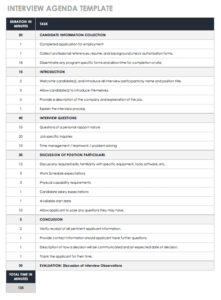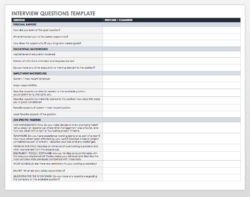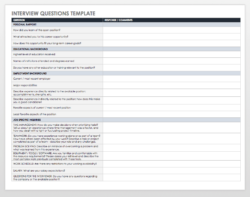Utilizing such a structure offers several advantages. It facilitates a more focused and efficient interview process, allowing for better comparison of candidates based on consistent criteria. Furthermore, it helps mitigate bias and ensures legal compliance by focusing on job-related questions. A well-designed structure can also improve the candidate experience by providing a clear and organized interview process.

This article will explore the key components of effective frameworks for conducting interviews, offer practical tips for development and implementation, and discuss best practices for maximizing their utility in various recruitment scenarios.
Key Components of an Effective Interview Framework
A well-structured interview framework comprises several key components that contribute to its effectiveness. These components work together to ensure a consistent, fair, and insightful evaluation of candidates.
1: Introduction and Opening Remarks: This section sets the tone for the interview and provides the candidate with an overview of the process. It typically includes a brief introduction of the interviewers and a summary of the topics to be discussed.
2: Essential Questions Related to the Role: This core section includes pre-determined questions designed to assess the candidate’s skills, experience, and qualifications relevant to the specific job requirements. These questions should be consistent across all candidates for the same position.
3: Behavioral Questions to Assess Competencies: This section focuses on past behavior as a predictor of future performance. Questions typically prompt candidates to describe specific situations and how they handled them, revealing key competencies and soft skills.
4: Opportunity for Candidate Questions: Allowing candidates to ask questions provides valuable insights into their interests, priorities, and understanding of the role and organization. It also contributes to a positive candidate experience.
5: Evaluation Criteria and Scoring System: A standardized evaluation system allows for objective comparison of candidates. This section typically outlines specific criteria and a scoring rubric to assess responses and qualifications.
6: Note-Taking Space for Observations and Follow-Up: Designated space for note-taking allows interviewers to record specific observations, impressions, and follow-up questions during the interview. This facilitates a more comprehensive and informed evaluation process.
7: Legal Considerations and Guidelines: This section ensures adherence to legal and ethical guidelines throughout the interview process. It may include reminders about permissible and impermissible questions, as well as guidance on maintaining confidentiality.
By incorporating these elements, organizations can develop robust frameworks for interviews that streamline the hiring process, improve candidate evaluation, and enhance overall recruitment outcomes.
How to Create an Effective Interview Guide Template
Developing a robust interview guide template requires careful planning and consideration of the specific requirements of the role and organization. A well-designed template ensures consistency, fairness, and efficiency throughout the hiring process.
1: Define the Job Requirements: Begin by thoroughly analyzing the target role and identifying the essential skills, experience, and qualifications necessary for success. This analysis should inform the development of targeted interview questions.
2: Structure the Template: Establish a clear structure for the template, including sections for introductions, essential questions, behavioral questions, candidate questions, evaluation criteria, note-taking, and legal considerations. This structure provides a consistent framework for each interview.
3: Develop Targeted Questions: Craft specific questions designed to assess the candidate’s qualifications and competencies related to the job requirements. Prioritize open-ended questions that encourage detailed responses and provide insights into the candidate’s thought processes.
4: Establish Evaluation Criteria: Define clear and objective criteria for evaluating candidate responses. Develop a scoring system or rubric to ensure consistent evaluation across multiple candidates and interviewers. This promotes fairness and reduces bias.
5: Incorporate Behavioral Questions: Include behavioral questions that prompt candidates to describe past experiences and how they handled specific situations. These questions provide valuable insights into the candidate’s soft skills, problem-solving abilities, and behavioral patterns.
6: Review and Refine: Before implementation, review and refine the template with relevant stakeholders, such as hiring managers and HR personnel. This ensures alignment with organizational goals and legal requirements.
7: Pilot Test the Template: Conduct pilot interviews using the template to identify any areas for improvement. Gather feedback from interviewers and candidates to refine the questions, structure, and evaluation process.
A comprehensive and well-structured template facilitates objective candidate evaluation, reduces bias, ensures legal compliance, and contributes to a positive candidate experience. Regular review and refinement are crucial to maintain its effectiveness and alignment with evolving organizational needs.
Standardized frameworks for conducting interviews provide a crucial structure for effective candidate evaluation. From ensuring consistency and legal compliance to facilitating more insightful conversations, the benefits are substantial. By incorporating key components such as targeted questions, behavioral inquiries, and clear evaluation criteria, organizations can significantly improve the hiring process. A well-designed template empowers interviewers to gather relevant information, mitigate bias, and ultimately select the most qualified candidates.
Strategic implementation of these structured guides represents a significant step towards more objective and effective talent acquisition. Organizations that prioritize the development and consistent use of robust interview frameworks are better positioned to attract, assess, and secure top talent, fostering a stronger and more competitive workforce.



